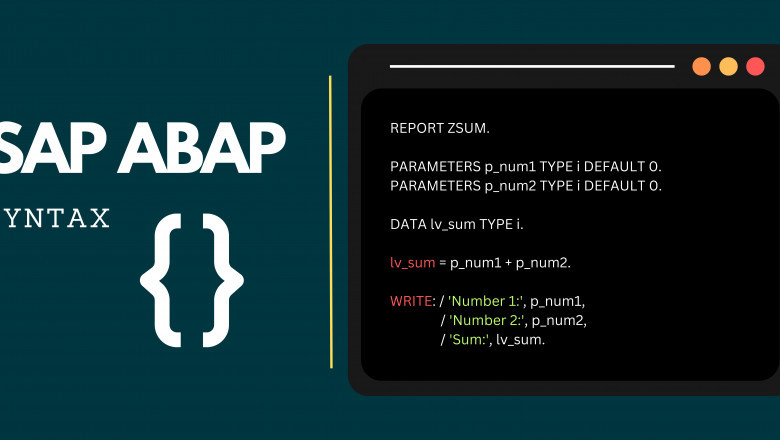views
In this fast-changing world of business software, SAP is a key tool that is helping companies in many ways. Well, it can help companies run smoothly as well as understand the data in a better way. The biggest part of how SAP works is ABAP, and it is a strong and reliable programming language made just for SAP systems.
Here in this article, we will understand the syntax of ABAP in detail. So, if you are looking to become an SAP ABAP developer, then consider applying for the SAP ABAP Training in Noida. This training in Noida will help you learn this from scratch. Also, this will help you understand and execute the SAP system in your organization correctly.
Syntax of ABAP:
Here we have discussed the syntax of ABAP in detail. So, if you are from Gurgaon and have taken SAP ABAP Training in Gurgaon, this may help you to get an opportunity to work as an intern, and you may also get placement opportunities for the same.
Basic Building Blocks: Statements and Keywords
In ABAP, the main part of your code is called a statement. Each statement does something specific and always ends with a period (.).
Statements are made using keywords — special words that ABAP understands and uses to perform actions.
For example, in the line below:
|
WRITE 'Hello'. |
● WRITE is a keyword that tells the system to show the text ‘Hello’ on the screen.
● The period means the end of the statement.
Data Types and Declarations: Setting Things Up
Before using any data in ABAP, you first need to tell the system what kind of data it is. ABAP comes with many built-in data types that help you define and work with different kinds of data.
Simple (Elementary) Types
C – Fixed-length text (character string)
N – Numbers stored as text (digits only)
D – Date (in YYYYMMDD format)
T – Time (in HHMMSS format)
I – Whole numbers (integers)
F – Decimal numbers (floating-point)
P – Decimal numbers used for calculations
X – Fixed-length binary data (hex values)
STRING – Text of any length
XSTRING – Binary data of any length
Complex Types
● Structures
A group of related fields combined under one name
● Internal Tables
A kind of list or array used to store multiple rows of data with the same format
Declaring Variables
To use a variable or constant, you must declare it first. You do this using keywords like:
● DATA – for regular variables
● TYPES – to define custom types
● CONSTANTS – for values that don’t change
● STATICS – for values that keep their data between program runs
Operators: Working with Data
ABAP also provides several operators to work with data. These help you assign values, do calculations, compare data, and more.
Assignment Operator
● = → Assigns the value on the right to the variable on the left.
Math Operators
● + (add), - (subtract), * (multiply), / (divide)
● DIV → Integer division (returns only whole number)
● MOD → Returns the remainder after division
Comparison Operators
● = or EQ → equal to
● <> or NE → not equal to
● < or LT → less than
● > or GT → greater than
● <= or LE → less than or equal to
● >= or GE → greater than or equal to
Control Structures: Managing Program Flow
To control how your program runs, ABAP uses control structures. These let your code make decisions or repeat actions
Conditional Statements
● IF...ENDIF: Runs a block of code only if a condition is true.
● IF...ELSE...ENDIF: Choose between two actions
● IF...ELSEIF...ELSE...ENDIF: Check multiple conditions
● CASE...WHEN...ENDCASE: Run different code depending on a variable’s value
Loops
● DO...ENDDO: Repeat a block of code (can specify how many times)
● WHILE...ENDWHILE: Keeps running the block of code as long as the condition remains true.
● LOOP AT itab...ENDLOOP: Go through each row in an internal table
Apart from this, if you have taken SAP ABAP Training in Delhi, then this may benefit you a lot. Various institutes in Delhi may help you understand how to write efficient and maintainable ABAP code through practical training. This may help you learn better, and you can also learn advanced topics.
Conclusion:
From the above discussion, it can be said that understanding ABAP syntax is the foundation for learning and working with ABAP. Everything starts here — from declaring variables and using operators to control how your program runs and handling data with internal tables. Each part of the syntax helps you build strong and efficient programs in SAP. Strong knowledge of syntax forms the core of any successful ABAP Training, enabling learners to create optimized and effective SAP applications.














Comments
0 comment